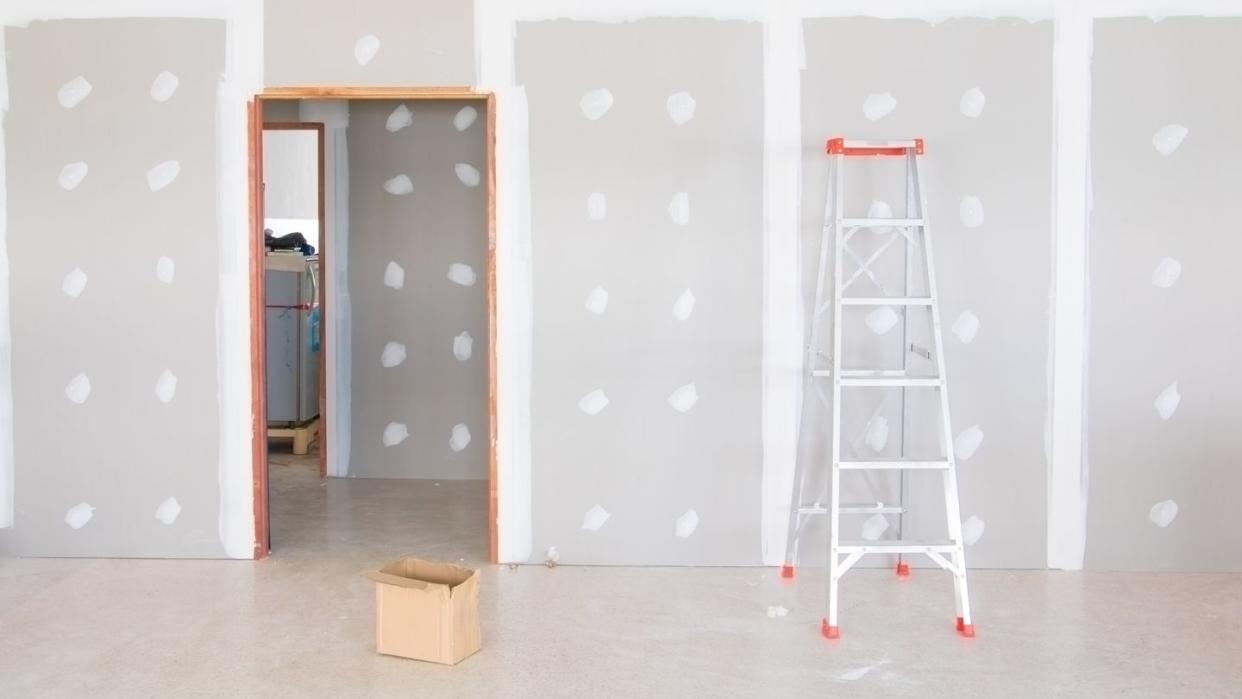What's the Actual Difference Between Sheetrock and Drywall?

"Hearst Magazines and Yahoo may earn commission or revenue on some items through these links."
When you're building a home, whether it's a renovation or ground-up construction project, there are an overwhelming number of material decisions to make: countertop stone, paint finish and color, and even flooring type. But there's one material that's a must-have, no matter the scope of your project, and that's drywall. If you've heard your contractor or the guy at the hardware store throw around the terms Sheetrock and drywall interchangeably, you may be confused. Are drywall and Sheetrock the same thing? Do I need both? What's the difference?
We're here to answer all of those questions and break down the makeup and use cases for the two materials. Read on to learn about the differences between drywall and Sheetrock and find out which one is right for your project.
What Is Drywall?
Drywall is a flat construction material that's used to create walls, ceilings, and other interior features, like arched doorways. All drywall is made of gypsum, aka calcium sulfate dihydrate, with or without additives (for instance, to improve its strength or moisture resistance). During construction, drywall boards are attached to the home's studs, over the insulation, and then sealed with a compound at the seams to create a smooth, flat surface that can then be topped with paint or another finish. According to Bauerle Roofing, drywall replaced plaster as the primary building material in new-build homes in the mid-1900s.
Drywall is used in both residential and commercial construction. There are a number of brands of drywall; some have mold-resistant and moisture-resistant properties, which make them well-suited for use in areas like bathrooms or basements, but the base materials of all drywall are the same. Drywall can also be fire-resistant, which is now the norm.
What Is Sheetrock?
Sheetrock is a trademarked brand name of drywall made by United States Gypsum Company, which is part of USG Corporation (USG). Sheetrock is known to be higher quality than other types of drywall, and it usually costs more. Contractors and homeowners alike use the terms drywall and Sheetrock interchangeably; like Kleenex, Sheetrock has become a household name. Sheetrock's primary benefit is that it doesn't emit sulfur odors, which can be harmful to your health and can even corrode metal, including screw heads. There are many different types of Sheetrock drywall panels, and they have different features and properties that you may want depending on your construction goals. Examples include moisture resistance, flame-resistant coatings, and sound dampening.
Common Brands and Types of Drywall
USG Sheetrock: Founded in 1902, USG has been producing Sheetrock drywall for more than a century.
American Gypsum Company ClassicRoc: AGC's ClassicRoc is wrapped in 100-percent recycled paper.
Certainteed Gypsum Board: Certaintted is primarily a manufacturer of exterior building products.
Georgia-Pacific ToughRock: ToughRock is the brand most comparable to Sheetrock in terms of product variety.
Gold Bond: Gold Bond is produced by National Gypsum Services Company's drywall division, Gold Bond Building Products.
Pabco QuietRock: QuietRock is sound-dampening gypsum drywall.
How Sheetrock Differs from Drywall
While all Sheetrock is drywall, not all drywall is sheetrock. Sheetrock contains unique and trademarked chemical compounds. Drywall can be manufactured by a number of construction material companies, but only USG makes Sheetrock.
Use
Sheetrock and drywall can be used interchangeably since they're designed for the same purposes and their makeup is similar. They're essentially the same thing.
Size and Thickness
Drywall boards come in three common sizes: 4x8 feet, 4x10 feet, and 4x12 feet. You'll find that there are more thickness options than size options, especially if you opt for Sheetrock.
1/4-inch drywall: The thinnest of all drywall options, this is most commonly used as a material to mend large drywall holes or cracks. It's ideal for walls with a subtle curve to them as the thin material is easiest to manipulate and bend.
3/8-inch drywall: This drywall is also a good choice for curved walls. This thickness is most often used to repair existing drywall that needs patching.
1/2-inch drywall: This is the most common thickness of drywall used in home interiors because it's relatively easy to carry and hang.
5/8-inch drywall: The thickest type of drywall, 5/8-inch drywall is often fire resistant and is the best choice for soundproofing. It's also great for ceiling applications because it can help prevent sagging over time.
Costs
According to Angi, most types of drywall cost between $0.40 to $0.65 per square foot. For Sheetrock brand drywall, expect to pay $0.62 per square foot. If you hire a professional to install your drywall, expect to pay between $50 to $100 per hour for labor on top of the material cost.
Quality
Sheetrock contains higher quality materials than generic drywall and is made in the United States. Sheetrock is also available in a wider variety of thicknesses, which allows you to further customize the drywall installation.
FAQs
Are Drywall and Sheetrock the Same Thing?
Yes! Sheetrock is a brand name of drywall. Sheetrock is made higher quality ingredients, but the terms refer to the same basic type of building material.
Who Calls Drywall Sheetrock?
Mostly contractors and construction professionals say Sheetrock. Sheetrock has become the household name for drywall. It's similar to how you might say "google" rather than "search" or "Kleenex" instead of "tissue."
Why Use Gypsum Board Instead of Drywall?
Gypsum board and drywall are one and the same. Gypsum board is simply a technical name given to a plaster-based wall finish that helps in creating light walls.
Working on a design project? Let us help!
Follow House Beautiful on Instagram and TikTok.
You Might Also Like

